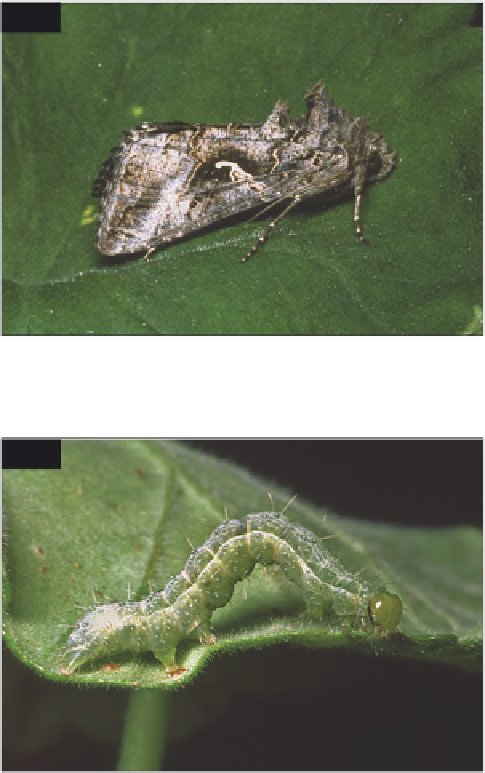Biology Reference
In-Depth Information
876
Autographa gamma
(Linnaeus) (
876-877
)
syn.
Plusia gamma
(Linnaeus)
Silver Y moth
An important horticultural pest, attacking greenhouse-
grown and outdoor plants, including azalea
(
Rhododendron
), carnation (
Dianthus caryophyllus
),
Chrysanthemum
,
Meconopsis
,
Pelargonium
and
snapdragon (
Antirrhinum
). Holarctic. A major
migratory species, in Europe spreading annually from
its permanent breeding grounds around the
Mediterranean to many western and northern areas.
DESCRIPTION
Adult:
35-45 mm wingspan; fore wings greyish brown
to velvet-black, suffused with whitish grey, often tinged
with purplish and each bearing a silver, Y-shaped mark;
hind wings light brown, with a broad brownish-black or
blackish border.
Larva:
up to 45 mm long; green to
blackish green, with pale irregular lines along the back
and a whitish or yellowish spiracular line; three pairs of
abdominal prolegs.
Pupa:
12-19 mm long; black or
blackish brown, and unpunctured; cremaster bulbous
and with curved, hook-tipped spines.
876
Silver Y moth (
Autographa gamma
).
877
LIFE HISTORY
This insect is unable to survive the winter in north-
western Europe, except in heated greenhouses.
Nevertheless, annual infestations are commonplace, the
first immigrant moths usually arriving in May or June.
Eggs are laid singly or in small groups on the leaves of
host plants, and hatch in 1-2 weeks according to
temperature. The larvae feed mainly at night, attacking
the leaves, buds and flowers. Individuals are fully
grown in about a month. They then spin flimsy silken
cocoons on the foodplant and pupate. Adults emerge a
week or two later. The moths sometimes fly during
daytime, but are usually most active at dusk, feeding
avidly on the nectar secreted by many wild and
cultivated flowers. Breeding is continuous under
favourable conditions; however, most adults reared in
northern Europe in the autumn do not breed locally but
migrate south to more favourable areas.
877
Larva of silver Y moth (
Autographa gamma
).
DAMAGE
Leaf damage is often extensive. However, this is less
important than direct damage to buds and flowers,
which often results in the production of malformed
blooms or the development of blind shoots.

Search WWH ::

Custom Search